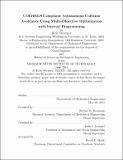COLREGS-compliant autonomous collision avoidance using multi-objective optimization with interval programming
Author(s)
Woerner, Kyle
DownloadFull printable version (29.36Mb)
Other Contributors
Massachusetts Institute of Technology. Department of Mechanical Engineering.
Advisor
Michael R. Benjamin and John J. Leonard.
Terms of use
Metadata
Show full item recordAbstract
High contact density environments are becoming ubiquitous in autonomous marine vehicle (AMV) operations. Safely managing these environments and their mission greatly taxes platforms. AMV collisions will likely increase as contact density increases. In situations where AMVs are not performing a collaborative mission but are using shared physical space such as multiple vehicles in the same harbor, a high demand exists for safe and efficient operation to minimize mission track deviations while preserving the safety and integrity of mission platforms. With no existing protocol for collision avoidance of AMVs, much effort to date has focused on individual ad hoc collision avoidance approaches that are self-serving, lack the uniformity of fleet-distributed protocols, and disregard the overall fleet efficiency when scaled to being in a contact-dense environment. This research shows that by applying interval programming and a collision avoidance protocol such as the International Regulations for Prevention of Collisions at Sea (COLREGS) to a fleet of AMVs operating in the same geographic area, the fleet achieves nearly identical efficiency concurrent with significant reductions in the collisions observed. A basic collision avoidance protocol was analyzed against a COLREGS-based algorithm while parameters key to collision avoidance were studied using Monte Carlo methods and regression analysis of both real-world and simulated statistical data. A testing metric was proposed for declaring AMVs as "COLREGS-compliant" for at-sea operations. This work tested five AMVs simultaneously with COLREGS collision avoidance-the largest test known to date.
Description
Thesis: Nav. E., Massachusetts Institute of Technology, Department of Mechanical Engineering, 2014. Thesis: S.M., Massachusetts Institute of Technology, Department of Mechanical Engineering, 2014. This electronic version was submitted by the student author. The certified thesis is available in the Institute Archives and Special Collections. Cataloged from student-submitted PDF version of thesis. Includes bibliographical references (pages 158-160).
Date issued
2014Department
Massachusetts Institute of Technology. Department of Mechanical EngineeringPublisher
Massachusetts Institute of Technology
Keywords
Mechanical Engineering.